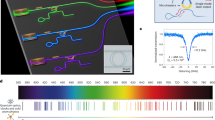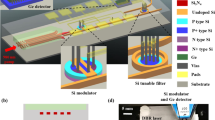Abstract
Fibre and bulk optical isolators are widely used to stabilize laser cavities by preventing unwanted feedback. However, their integrated counterparts have been slow to be adopted. Although several strategies for on-chip optical isolation have been realized, these rely on either integration of magneto-optic materials or high-frequency modulation with acousto-optic or electro-optic modulators. Here we demonstrate an integrated approach for passively isolating a continuous-wave laser using the intrinsically non-reciprocal Kerr nonlinearity in ring resonators. Using silicon nitride as a model platform, we achieve single ring isolation of 17–23 dB with 1.8–5.5-dB insertion loss, and a cascaded ring isolation of 35 dB with 5-dB insertion loss. Employing these devices, we demonstrate hybrid integration and isolation with a semiconductor laser chip.
This is a preview of subscription content, access via your institution
Access options
Access Nature and 54 other Nature Portfolio journals
Get Nature+, our best-value online-access subscription
$29.99 / 30 days
cancel any time
Subscribe to this journal
Receive 12 print issues and online access
$209.00 per year
only $17.42 per issue
Buy this article
- Purchase on Springer Link
- Instant access to full article PDF
Prices may be subject to local taxes which are calculated during checkout





Similar content being viewed by others
Data availability
All data are available from the corresponding authors upon reasonable request.
References
Xiang, C. et al. Laser soliton microcombs heterogeneously integrated on silicon. Science 373, 99–103 (2021).
Kippenberg, T. J., Gaeta, A. L., Lipson, M. & Gorodetsky, M. L. Dissipative Kerr solitons in optical microresonators. Science 361, eaan8083 (2018).
de Beeck, C. O. et al. III/V-on-lithium niobate amplifiers and lasers. Optica 8, 1288–1289 (2021).
Shen, B. et al. Integrated turnkey soliton microcombs. Nature 582, 365–369 (2020).
Jin, W. et al. Hertz-linewidth semiconductor lasers using CMOS-ready ultra-high-Q microresonators. Nat. Photon. 15, 346–353 (2021).
Yang, K. Y. et al. Inverse-designed multi-dimensional silicon photonic transmitters. Preprint at https://arxiv.org/abs/2103.14139 (2021).
Shu, H. et al. Microcomb-driven silicon photonic systems. Nature 605, 457–463 (2022).
Liu, Y. et al. A photonic integrated circuit based erbium-doped amplifier. Science 376, 1309–1313 (2022).
Jalas, D. et al. What is—and what is not—an optical isolator. Nat. Photon. 7, 579–582 (2013).
Srinivasan, K. & Stadler, B. J. H. Magneto-optical materials and designs for integrated TE-and TM-mode planar waveguide isolators: a review. Opt. Mater. Express 8, 3307–3318 (2018).
Du, Q. et al. Monolithic on-chip magneto-optical isolator with 3-dB insertion loss and 40-dB isolation ratio. ACS Photonics 5, 5010–5016 (2018).
Bi, L. et al. On-chip optical isolation in monolithically integrated non-reciprocal optical resonators. Nat. Photon. 5, 758–762 (2011).
Yan, W. et al. Waveguide-integrated high-performance magneto-optical isolators and circulators on silicon nitride platforms. Optica 7, 1555–1562 (2020).
Tzuang, L. D., Fang, K., Nussenzveig, P., Fan, S. & Lipson, M. Non-reciprocal phase shift induced by an effective magnetic flux for light. Nat. Photon. 8, 701–705 (2014).
Fang, K. et al. Generalized non-reciprocity in an optomechanical circuit via synthetic magnetism and reservoir engineering. Nat. Phys. 13, 465–471 (2017).
Kim, J. H., Kuzyk, M. C., Han, K., Wang, H. & Bahl, G. Non-reciprocal brillouin scattering induced transparency. Nat. Phys. 11, 275–280 (2015).
Kittlaus, E. A., Otterstrom, N. T., Kharel, P., Gertler, S. & Rakich, P. T. Non-reciprocal interband Brillouin modulation. Nat. Photon. 12, 613–619 (2018).
Tian, H. et al. Magnetic-free silicon nitride integrated optical isolator. Nat. Photon. 15, 828–836 (2021).
Kittlaus, E. A. et al. Electrically driven acousto-optics and broadband non-reciprocity in silicon photonics. Nat. Photon. 15, 43–52 (2021).
Sohn, D. B., Örsel, O. E. & Bahl, G. Electrically driven optical isolation through phonon-mediated photonic autler–townes splitting. Nat. Photon. 15, 822–827 (2021).
Sounas, D. L., Soric, J. & Alu, A. Broadband passive isolators based on coupled nonlinear resonances. Nat. Electron. 1, 113–119 (2018).
Yang, K. Y. et al. Inverse-designed non-reciprocal pulse router for chip-based lidar. Nat. Photon. 14, 369–374 (2020).
Hua, S. et al. Demonstration of a chip-based optical isolator with parametric amplification. Nat. Commun. 7, 13657 (2016).
Del Bino, L. et al. Microresonator isolators and circulators based on the intrinsic nonreciprocity of the Kerr effect. Optica 5, 279–282 (2018).
Cao, Q.-T. et al. Reconfigurable symmetry-broken laser in a symmetric microcavity. Nat. Commun. 11, 1136 (2020).
Xuan, Y. et al. High-Q silicon nitride microresonators exhibiting low-power frequency comb initiation. Optica 3, 1171–1180 (2016).
Wilson, D. J. et al. Integrated gallium phosphide nonlinear photonics. Nat. Photon. 14, 57–62 (2020).
Jung, H. et al. Tantala Kerr nonlinear integrated photonics. Optica 8, 811–817 (2021).
Lu, X., Lee, J. Y., Rogers, S. & Lin, Q. Optical Kerr nonlinearity in a high-Q silicon carbide microresonator. Opt. Express 22, 30826–30832 (2014).
Guidry, M. A. et al. Optical parametric oscillation in silicon carbide nanophotonics. Optica 7, 1139–1142 (2020).
Lu, J. et al. Periodically poled thin-film lithium niobate microring resonators with a second-harmonic generation efficiency of 250,000%/w. Optica 6, 1455–1460 (2019).
Wang, C. et al. Monolithic lithium niobate photonic circuits for Kerr frequency comb generation and modulation. Nat. Commun. 10, 978 (2019).
Shi, Y., Yu, Z. & Fan, S. Limitations of nonlinear optical isolators due to dynamic reciprocity. Nat. Photon. 9, 388–392 (2015).
Del Bino, L., Silver, J. M., Stebbings, S. L. & Del’Haye, P. Symmetry breaking of counter-propagating light in a nonlinear resonator. Sci. Rep. 7, 43142 (2017).
Cao, Q.-T. et al. Experimental demonstration of spontaneous chirality in a nonlinear microresonator. Phys. Rev. Lett. 118, 033901 (2017).
Moss, D. J., Morandotti, R., Gaeta, A. L. & Lipson, M. New CMOS-compatible platforms based on silicon nitride and hydex for nonlinear optics. Nat. Photon. 7, 597–607 (2013).
Kim, S. et al. Dispersion engineering and frequency comb generation in thin silicon nitride concentric microresonators. Nat. Commun. 8, 372 (2017).
Gao, M. et al. Probing material absorption and optical nonlinearity of integrated photonic materials. Nat. Commun. 13, 3323 (2022).
Padmaraju, K. & Bergman, K. Resolving the thermal challenges for silicon microring resonator devices. Nanophotonics 3, 269–281 (2014).
Herrmann, J. F. et al. Mirror symmetric on-chip frequency circulation of light. Nat. Photon. 16, 603–608 (2022).
Lira, H., Yu, Z., Fan, S. & Lipson, M. Electrically driven nonreciprocity induced by interband photonic transition on a silicon chip. Phys. Rev. Lett. 109, 033901 (2012).
Dostart, N., Gevorgyan, H., Onural, D. & Popović, M. A. Optical isolation using microring modulators. Opt. Lett. 46, 460–463 (2021).
Liu, J. et al. High-yield, wafer-scale fabrication of ultralow-loss, dispersion-engineered silicon nitride photonic circuits. Nat. Commun. 12, 2236 (2021).
Acknowledgements
We thank D. Carlson, T. Briles, J. Zang, J. Black, S.-P. Yu, F. M. Mayor, J. F. Herrmann, A. H. Safavi-Naeini, S. Papp and R. Trivedi for collaboration and discussions, and L. Wu and K. Vahala for assistance with the DFB laser. A.W. acknowledges the Herb and Jane Dwight Stanford Graduate Fellowship (SGF) and the NTT Research Fellowship for support. G.H.A. acknowledges support from STMicroelectronics Stanford Graduate Fellowship (SGF) and Kwanjeong Educational Foundation. K.V.G. acknowledges support from the Research Foundation – Flanders (FWO) (12ZB520N). The authors from Stanford acknowledge funding support from DARPA under the LUMOS programme. Part of this work was performed at the Stanford Nano Shared Facilities (SNSF)/Stanford Nanofabrication Facility (SNF), supported by the National Science Foundation under award no. ECCS-2026822.
Author information
Authors and Affiliations
Contributions
A.D.W., G.H.A., K.V.G. and K.Y.Y. conceived of the project. A.D.W., G.H.A. and K.V.G. performed the experiments. G.H.A. developed the silicon-nitride fabrication process and fabricated the devices. L.C. and J.E.B. provided the semiconductor laser chip and experimental guidance. J.V. supervised the project. All authors contributed to data analysis and writing of the manuscript.
Corresponding authors
Ethics declarations
Competing interests
The authors declare no competing interests.
Peer review
Peer review information
Nature Photonics thanks Sunil Mittal and the other, anonymous, reviewer(s) for their contribution to the peer review of this work.
Additional information
Publisher’s note Springer Nature remains neutral with regard to jurisdictional claims in published maps and institutional affiliations.
Supplementary information
Supplementary Information
Supplementary Figs. 1–11, Discussion and Table 1.
Rights and permissions
Springer Nature or its licensor (e.g. a society or other partner) holds exclusive rights to this article under a publishing agreement with the author(s) or other rightsholder(s); author self-archiving of the accepted manuscript version of this article is solely governed by the terms of such publishing agreement and applicable law.
About this article
Cite this article
White, A.D., Ahn, G.H., Gasse, K.V. et al. Integrated passive nonlinear optical isolators. Nat. Photon. 17, 143–149 (2023). https://doi.org/10.1038/s41566-022-01110-y
Received:
Accepted:
Published:
Issue Date:
DOI: https://doi.org/10.1038/s41566-022-01110-y
This article is cited by
-
Nozaki–Bekki solitons in semiconductor lasers
Nature (2024)
-
Passive bias-free non-reciprocal metasurfaces based on thermally nonlinear quasi-bound states in the continuum
Nature Photonics (2024)
-
Integrated electro-optic isolator on thin-film lithium niobate
Nature Photonics (2023)
-
Higher-dimensional processing using a photonic tensor core with continuous-time data
Nature Photonics (2023)



